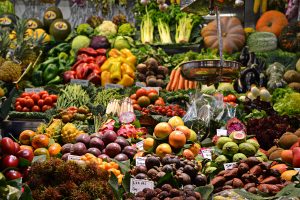Blog
Seven facts you didn’t know about the global food landscape
Written by Mark Hawkins
January 30, 2020
Globally, food systems are facing a number of challenges, from climate change to a projected population of 10 billion people by 2050. Following LIDC and Nature Food’s debate Beyond Foresight to the Frontier of Food: The Global Food Landscape in 2050, we wanted to highlight seven fascinating research stories on the global food landscape. These include comprehensive studies of the global food system to small innovations in food technology.
1) The EAT–Lancet Commission: Food in the Anthropocene
Over 820 million people globally have insufficient food and many more eat unhealthily. On top of this, food production places immense pressure on Earth’s ecosystems. According to the EAT-Lancet Commission, we will need to reduce sugar and red meat consumption by 50% and increase healthy food production (such as nuts, fruits and legumes) by 100% to tackle these crises. On top of this, we will need to change how we use land and fertilisers. This is just the tip of the iceberg in this in-depth study of global food systems involving researchers from all over the world.
2) Community Food Enterprise: Local Success in a Global Marketplace
What’s more, we need to change to more local forms of production and consumption in the fight against climate change. With the pollution of large global companies increasingly in the limelight, this study seeks to find out if local food enterprises can be an alternative. Globally, community organisations are adapting and scaling up to meet consumers’ demands and changes in the global market. Will they be able to meet the bottom line of people, profit and planet?
3) Extraction of proteins from two marine macroalgae
Food demand is growing at pace, with the ‘food frontier’ of ten million humans approaching fast. Yet arable land and freshwater resources are growing scarce. What better place to look than the sea? Luckily, marine algae can be farmed and are a good source of protein and antioxidants. The researchers envisage an integrated, no waste process, that would turn the algae into food.
4) Plant Factory with Artificial Lighting
Around the world, populations are growing and becoming more urbanised. As a result, there are increasing demands for food as well as difficulties in accessing fresh produce. In this story, indoor farming complexes offer a number of advantages. For example, researchers offer a way around limited land space and a way to improve public health through easy access to fresh produce. They also offer a number of environmental benefits from more efficient use of resources to reduced transport requirements. On top of all this, these wonders of technology require no pesticides and have far higher yields when compared to conventional field production.
5) Integrated Development Solutions in Honduras
This particular study looks at malnutrition in Honduras. Researchers find that malnutrition is caused by a combination of factors, from land degradation to a family’s housing situation. This innovative approach supported by the UNDP addresses complex social environmental and economic factors underpinning malnutrition. New methods of gathering data underpin the study. They find integrated development solutions offer a chance to upgrade development interventions. You can find more information on the Integrated Solutions method here.
6) Our Future in the Land
A degraded environment, spiralling ill-health, impoverished high streets and widespread misuse and wastage of food. This RSA organised study finds that the UK’s focus on cheap food has all these nefarious effects. To respond, researchers argue that we need to unleash a “fourth agricultural revolution”. How? By establishing a ‘National Nature Service’ that aims to include young people in agriculture and a national ‘Agroecology Development Bank’ to give farmers access to funding to transition to sustainable standards.
7) Challenges and opportunities to the African agriculture and food systems
Sub-Saharan Africa will be a key site of change going forward, with 50 percent of global population due to increase by 2050. This massive demographic boom will come with a whole host of challenges, not least how to feed so many people. On top of this the region faces a number of challenges, including loss of farm land to the development of cities and industry, weather changes associated with climate change etc. Luckily a number of strategies to address these challenges are underway, such as a move to nutrition-sensitive agriculture.
LIDC intern, Mark Hawkins, is currently undertaking an MSc in Environment, Politics and Development at LIDC core member institution, SOAS University of London.

